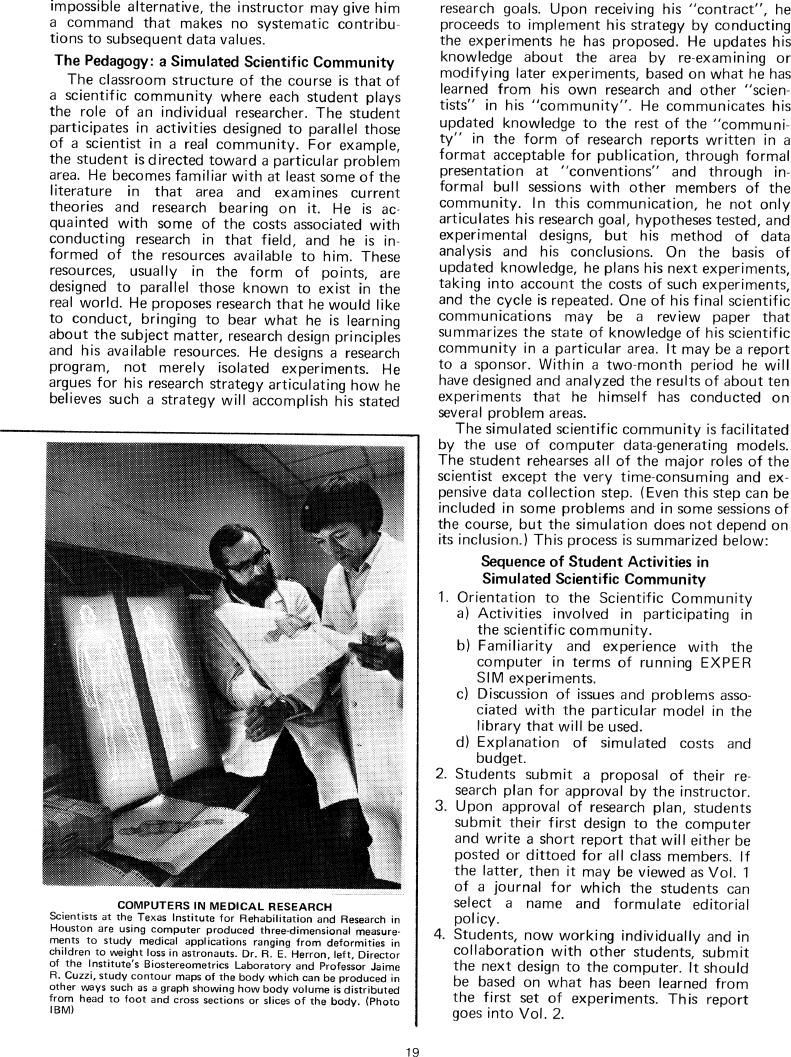The Best of Creative Computing Volume 1 (published 1976)
Exper Sim: Experimental Simulation

impossible alternative, the instructor may give him a command that makes no
systematic contributions to subsequent data values.
The Pedagogy: a Simulated Scientific Community
The classroom structure of the course is that of a scientific community where
each student plays the role of an individual researcher. The student
participates in activities designed to parallel those of a scientist in a real
community. For example,the student is directed toward a particular problem area.
He becomes familiar with at least some of the literature in that area and
examines current theories and research bearing on it. He is acquainted with some
of the costs associated with conducting research in that field, and he is
informed of the resources available to him. These resources, usually in the form
of points, are designed to parallel those known to exist in the real world. He
proposes research that he would like to conduct, bringing to bear what he is
learning about the subject matter, research design principles and his available
resources. He designs a research program, not merely isolated experiments. He
argues for his research strategy articulating how he believes such a strategy
will accomplish his stated
COMPUTERS IN MEDICAL RESEARCH
Scientists at the Texas Institute for Rehabilitation and Research in Houston are
using computer produced three-dimensional measurements to study medical
applications ranging from deformities in children to weight loss in astronauts.
Dr. R. E. Herron, left, Director of the lnstitute's Biostereometrics Laboratory
and Professor Jaime R. Cuzzi, study contour maps of the body which can be
produced in other ways such as a graph showing how body volume is distributed
from head to foot and cross sections or slices of the body. (Photo IBM)
research goals. Upon receiving his "contract", he proceeds to implement his
strategy by conducting the experiments he has proposed. He updates his knowledge
about the area by re-examining or modifying later experiments, based on what he
has learned from his own research and other ”scientists" in his "community".
He communicates his updated knowledge to the rest of the "community" in the form
of research reports written in a format acceptable for publication, through
formal presentation at "conventions" and through informal bull sessions with
other members of the community. ln this communication, he not only articulates
his research goal, hypotheses tested, and experimental designs, but his method
of data analysis and his conclusions. On the basis of updated knowledge, he
plans his next experiments, taking into account the costs of such experiments,
and the cycle is repeated. One of his final scientific communications may be a
review paper that summarizes the state of knowledge of his scientific community
in a particular area. It may be a report to a sponsor. Within a two-month period
he will have designed and analyzed the results of about ten experiments that he
himself has conducted on several problem areas.
The simulated scientific community is facilitated by the use of computer
data-generating models. The student rehearses all of the major roles of the
scientist except the very time-consuming and expensive data collection step.
(Even this step can be included in some problems and in some sessions of the
course, but the simulation does not depend on its inclusion.) This process is
summarized below:
Sequence of Student Activities in
Simulated Scientific Community
1. Orientation to the Scientific Community
a) Activities involved in participating in the scientific community.
b) Familiarity and experience with the computer in terms of running EXPER SIM
experiments.
c) Discussion of issues and problems associated with the particular model in the
library that will be used.
d) Explanation of simulated costs and budget.
2. Students submit a proposal of their research plan for approval by the
instructor.
3. Upon approval of research plan, students submit their first design to the
computer and write a short report that will either be posted or dittoed for all
class members. If the latter, then it may be viewed as Vol. 1 of a journal for
which the students can select a name and formulate editorial policy.
4. Students, now working individually and in collaboration with other students,
submit the next design to the computer. lt should be based on what has been
learned from the first set of experiments. This report
goes into Vol. 2.


